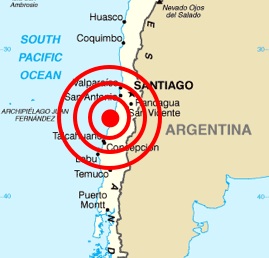Science News
Earthquake Shortens Day
March 3, 2010

The magnitude 8.8 earthquake in Chile last week was the fifth largest recorded since seismographs started measuring earthquakes in 1900. Earthquakes this large occur extremely rarely, and they do more than just devastate an area—they shorten days!
NASA’s Jet Propulsion Laboratory distributed a news release yesterday stating that Saturday’s shaking could have shortened the Earth day by 1.26 microseconds (in case you’re wondering, a microsecond is one millionth of a second).
“Could have shortened” because scientists can only measure Earth days with accuracy up to 20 microseconds. The estimate is based on a calculation “using a complex model,” according to the press release.
The findings seem plausible to local earthquake scientist Wayne Thatcher of the US Geological Survey in Menlo Park. He uses GPS and satellite data to measure the displacement around earthquake faults and volcanoes in the western US. “If a large enough earthquake occurs, there’s a redistribution of mass of the Earth around the fault. It can be enough to adjust the rate of rotation.”
The redistribution of mass—or movement of Earth’s figure axis—is about 3 inches according the JPL calculations.
Thatcher likens it to the spin of a figure skater—if the skater brings their arms or legs out, it will change the speed of their rotation.
Using the same calculations, JPL’s Richard Gross was also able to measure the effect of the 2004 magnitude 9.1 Sumatran earthquake. While that earthquake was larger than the Chilean earthquake by a factor of 3 or 4, the redistribution of mass was less. Due to the location, it was only 2.76 inches.
This information is fascinating, but will the newly shortened days cause people to over-sleep?
Don't set those alarms any earlier, Thatcher says we'll be fine. “No one except us scientists will notice the difference.”